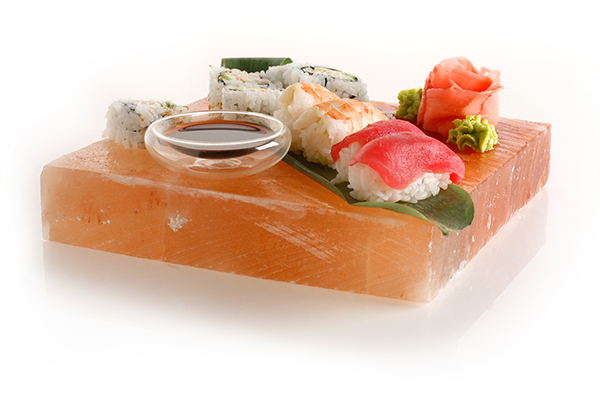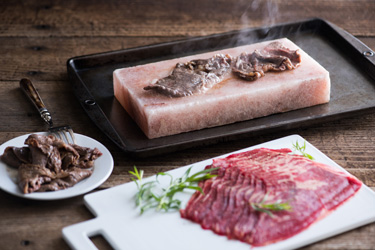Himalayan Salt Block Cooking:

Himalayan salt blocks aren't your typical cookware! They're incredibly dense and conduct heat efficiently but slowly, which is why the slab retains heat so well and seasons food evenly. Slabs can crack if they are heated (or chilled) too quickly as any moisture trapped inside expands, so it's best to follow these usage suggestions and care instructions to get optimum life from your salt block.
For Serving:
Himalayan salt slabs are perfect to use as serving platters. The slab can be chilled in the refrigerator for serving items such as sushi or cheese, or even frozen in the freezer, providing a new way to present cold desserts, even sorbet! Moist foods will pick up more salty flavor, while their denser and drier counterparts will be presented beautifully and imaginatively.
How will the Himalayan salt slab affect different types of foods?
Foods placed on a Himalayan crystal salt slab take on a light, clean, naturally salty flavor while absorbing minerals necessary for good health and longevity. When placed on the Himalayan salt block for an extended period of time, thinly sliced fish such as salmon, tuna and whitefish will begin to cure from the salt, which acts as a preservative. Generally, a natural salt slab will add a hint of salty taste to moist or wet foods, but will have no effect on dry foods. For example, if you use your salt slab to serve cheese and crackers, it will lend a bit of saltiness to the cheese but the taste of the crackers will remain the same
How to cure foods using a Himalayan salt block:
Himalayan salt blocks can be used to cure thinly sliced meats, fish and seafood. Simply chill your natural salt slab in the refrigerator for several hours, then place thin strips of ahi tuna or beef carpaccio directly onto the salt slab and observe as the curing process slowly takes place. The irregular shades of pink and varying textures of this 100% pure wonder of nature make for intriguing conversation and an attractive, natural serving platter for all your favorite foods.
For Cooking:
Imagine cooking your food on a 250 million-year-old slab of pure, crystallized mineral salt. What better way to bring the clean taste and nutritional benefits of pure mineral salt to your table? Himalayan pink salt slabs can be heated to as high as 450 degrees Fahrenheit and used to lightly sear all sorts of delicious foods. When the cooking is through, your mineral salt slab will slowly return to room temperature for future use as a cold serving plate.
How to sear meat, fish and vegetables with your Himalayan salt slab:
Your Himalayan salt slab can be slow-heated, either in the oven or over a gas flame or electric burner, for searing or lightly grilling meat, fish or vegetables. Note that when subjected to high temperatures, the salt slab will turn white in some spots. This is normal. As it cools, your Himalayan salt slab will regain more of its original coloring. Because of the potential for this slight alteration in appearance from heat, you may wish to preserve one slab for display and/or serving, and one slab for cooking if this is a concern. When cooking with your salt slab, ensure that it is completely dry prior to applying any heat, as lingering moisture inside the slab may expand and cause damage to the slab. Typically the dry time should be at least 24 hours since the slab's last contact with any moisture.

To heat in the oven: Place your dry salt slab into a cold oven and turn the heat to 250 degrees Fahrenheit. When the oven has reached 250 degrees, remove the salt slab and let cool for about 30 minutes. Then return it to the oven and set the temperature for 400 to 450 degrees Fahrenheit. The heat will distribute slowly and evenly throughout.
To heat using a gas burner: Place your dry Himalayan salt slab over a low gas flame for 15 minutes. If you desire a higher temperature, heat for an additional 15 minutes on a medium-high gas flame.
To heat on an electric stove: Use a metal spacer or wok ring to prevent the salt slab from making direct contact with the heating element. Follow instructions for gas heating.
Once you've thoroughly heated your Himalayan salt slab, you're ready to sear your meat, fish and/or vegetables. Place the thoroughly heated salt plate on a heatproof surface. Lightly toss your meat, fish or vegetables in oil, spices and herbs. You may also wish to lightly drizzle the salt cooking surface with olive oil, adjusting to your desired level of saltiness (less oil will cause more salting of your food and vice versa). Place directly onto the heated salt slab, then cook to desired doneness, stirring and moving around the salt plate as you would any other grilling surface. Your salt block will retain the heated temperature for 20 to 30 minutes. Avoid making direct contact with the salt block for some time after cooking the meal, as it will take several hours to cool completely.
Ideas for Serving Chilled:
- Sushi
- Salads
- Cold appetizers
- Fruits & vegetables
- Cheese
- Cold dips
- Cured meats
- Tuna Tartare
- Shellfish
- Hard-boiled eggs
- Ice cream & sorbet
- Chilled desserts
Ideas for Searing:
- Thinly sliced beef or veal
- Chicken, duck or other poultry
- Scallops, shrimp, prawns or other shellfish
- Fish filets
- Vegetables (broccoli, zucchini, asparagus)
- Eggs
- Apples, pears, pineapple, bananas and other fruit
Ideas for Curing:
- Thinly sliced ahi tuna, salmon or other fish
- Shrimp, prawns, scallops or other shellfish
- Carpaccio
Himalayan Salt Block Cleaning & Care:
To clean your Himalayan salt block, wipe with a clean, damp cloth or paper towel and remove any remaining food bits. Avoid running your natural salt block under water or submerging in water, as any remaining moisture in the salt slab can cause breakage upon heating. Be sure to let your salt slab dry for at least 24 hours after exposure to any moisture. There is no need to use soap or detergent on your Himalayan salt slab, as it is naturally anti-fungal and anti-microbial. You may wish to freshen your salt block with a bit of lemon juice from time to time.
Note that the appearance of your Himalayan salt slab will change over time. The more varieties of foods you cook and serve on your salt plate, the more likely the surface will acquire various, interesting new colors and shades. This merely adds to the irregular beauty of the Himalayan salt slab. Your salt block may also develop small fissures and cracks over time; this is typical with regular use. When the salt block finally gets too small for cooking or serving on, it will be a perfect size to grate over your food, break up for making soup, or even to throw into your tub for a detoxifying salt bath.
SALT BLOCKS ARE A NATURAL PRODUCT
Himalayan pink salt blocks are a natural product mined from the Salt Range in Pakistan. No slab is alike; each has unique color and inclusions, resulting in a different threshold for pressure and temperature. While slabs are examined for weak spots, SaltWorks is not responsible for damages, injury, or loss due to any use of Himalayan salt products.
